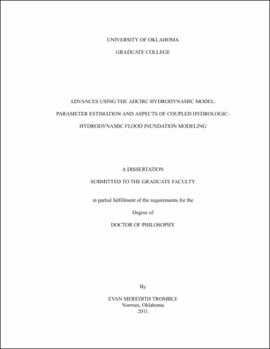| dc.contributor.advisor | Kolar, Randall L | |
| dc.creator | Tromble, Evan Meredith | |
| dc.date.accessioned | 2019-04-27T21:31:47Z | |
| dc.date.available | 2019-04-27T21:31:47Z | |
| dc.date.issued | 2011 | |
| dc.identifier | 99270634402042 | |
| dc.identifier.uri | https://hdl.handle.net/11244/318925 | |
| dc.description.abstract | The ADCIRC hydrodynamic model has been used extensively for coastal modeling applications over the last twenty years. Within the last decade, modeling of hurricane storm surge has become one of its principal applications. Utilization of ADCIRC for these problems has required additional model development. Two areas for model development are focused on in this dissertation. First, the numerical parameter, G, is analyzed in ADCIRC. Then, aspects of coupled hydrologic-hydrodynamic modeling for coastal flood inundation are explored using ADCIRC. | |
| dc.description.abstract | The numerical parameter, G, in the generalized wave continuity equation, which is one of the governing equations in ADCIRC, is analyzed using dispersion analysis results as a guide for parameter selection. Results show traditional analysis techniques, which are limited to linear systems, do not produce optimal results for non-linear problems. Therefore, application of the Forward Sensitivity Method (FSM) to ADCIRC, in 1-D, is explored. Results show model sensitivity to G computed using the FSM is equivalent to numerical analog values using model results. Additionally, the data assimilation step in the FSM can be used to successfully recover target values using the model errors and sensitivity values. However, due to the variability of the sensitivities, recovery of target G values depends on the initial coefficient set specification. Furthermore, sensitivity results show generation of spurious oscillations in the elevation and velocity results when G is set too high. | |
| dc.description.abstract | The preliminary model coupling is completed using 1-D channel routing and ADCIRC models to analyze the impact of the location of the coupling, the types of boundary conditions used for the models, and the complexity of the momentum equation approximation in the channel routing model. Results show one-way coupling of a model with kinematic wave channel routing to ADCIRC is acceptable if the hand-off point is placed upstream of major backwater effects. Additionally, ADCIRC results are best when flux values are used at the upstream boundary. | |
| dc.description.abstract | Finally, a one-way coupled model system using output from a hydrologic model as the upstream boundary condition in ADCIRC is implemented. The target area for this 2-D application is coastal North Carolina, specifically the Tar-Pamlico and Neuse River basins and Pamlico Sound. The hand-off points on the rivers are placed tens of km inland from the Pamlico Sound to ensure ADCIRC handles areas impacted by tides and storm surge. Results show ADCIRC accurately represents specified boundary discharges at the upstream extents of the rivers and can model inundation of the coastal plain due to the combined effects of rainfall-runoff and hurricane storm surge. A hindcast of Hurricane Isabel shows the coupled system accurately models total water level at the USGS location at Washington where the Tar-Pamlico River discharges into the Pamlico Sound. However, inadequate resolution and issues with the wet/dry algorithm in ADCIRC give rise to some mass balance problems in the river reaches that limit the accuracy of results in the downstream portions of the rivers. | |
| dc.format.extent | 455 pages | |
| dc.format.medium | application.pdf | |
| dc.language | en_US | |
| dc.relation.requires | Adobe Acrobat Reader | |
| dc.subject | Hydrodynamics--Computer programs | |
| dc.subject | Coast changes--Mathematical models | |
| dc.subject | Coastal zone management | |
| dc.title | Advances using the ADCIRC hydrodynamic model: Parameter estimation and aspects of coupled hydrologic-hydrodynamic flood inundation modeling | |
| dc.type | text | |
| dc.type | document | |
| dc.thesis.degree | Ph.D. | |
| ou.group | College of Engineering::School of Civil Engineering and Environmental Science | |
